
by Jeremy Potter, Expedition Coordinator, NOAA Office of Ocean Exploration and Research
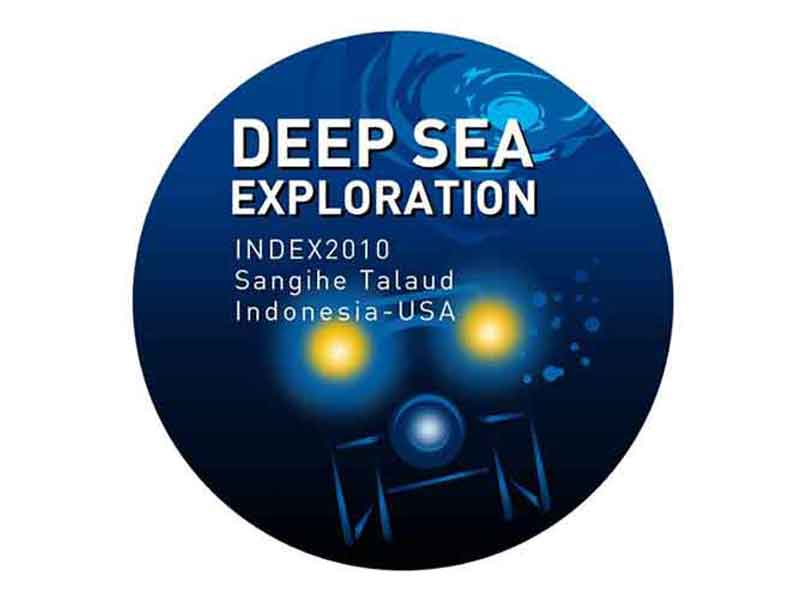
Join us for the INDEX 2010: “Indonesia-USA Deep-Sea Exploration of the Sangihe Talaud Region”. This unique expedition to one of the most biologically diverse areas of the world’s ocean. Image courtesy of the NOAA Office of Ocean Exploration and Research, INDEX-SATAL 2010. Download larger version (jpg, 180 KB).
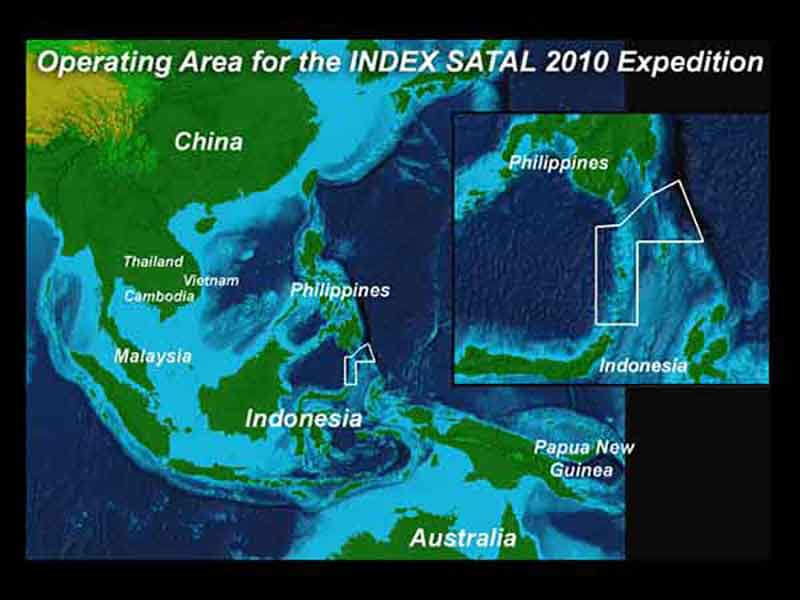
Map of the operating area for INDEX-SATAL 2010. The white tomahawk-shaped box is where both the Baruna Jaya IV and Okeanos Explorer will be conducting joint operations this summer. The inset boxes reflect suggested priority areas. Image courtesy of the NOAA Office of Ocean Exploration and Research. Download map (jpg, 317 KB).
INDEX-SATAL 2010 will be the first in a series of joint Indonesia-U.S. expeditions to explore the ocean and help advance our knowledge, use, and protection of the ocean and its resources. This year’s joint expedition is staged from two ships: NOAA Ship Okeanos Explorer and the Indonesian research vessel, Baruna Jaya IV.
From June to August 2010, an international team of scientists and technicians both on ships and on shore will conduct exploratory investigations on the diversity and distribution of deep-sea habitats and marine life in Indonesian waters. They will focus on the water column and benthic environments in unknown ocean areas in SATAL – a contraction of Sangihe and Talaud – two island chains stretching northeast of North Sulawesi.
During the expedition U.S. and Indonesian scientists will work side-by-side on two ships, the Okeanos Explorer and the Indonesian research vessel Baruna Jaya IV, and at Exploration Command Centers (ECCs) ashore.
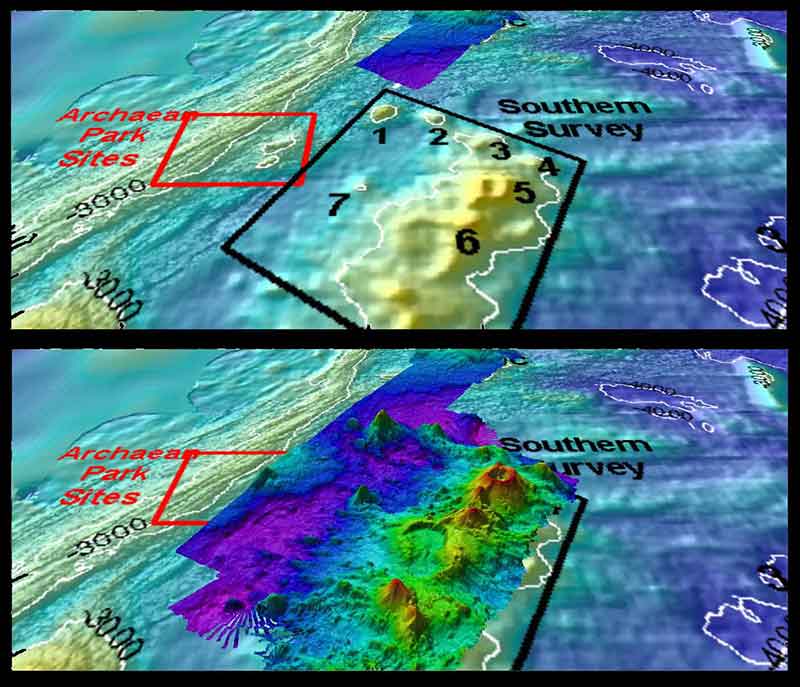
This "before and after" image provides a glimpse of Okeanos Explorer’s EM302 mapping system capabilities in deep water. The top image shows what we previously knew about the seafloor terrain in the southern Mariana region from satellite altimetry data. The bottom image includes an overlay of the information provided by the ship's EM302 multibeam system. Okeanos Explorer will focus on mapping waters deeper than 2,000 meters during the expedition, while Baruna Jaya IV will collect multibeam data down to 2,000 meters – the maximum rating of its multibeam system. Image courtesy of the NOAA Office of Ocean Exploration and Research, INDEX-SATAL 2010. Download larger version (jpg, 867 KB).
Starting on June 24, scientists and technicians on NOAA Ship Okeanos Explorer will create bathymetric maps of the seafloor using the ship's multibeam sonar, characterize the water column with the CTD/rosette, and explore seafloor habitats using the Little Hercules (“Little Herc”) remotely operated vehicle (ROV).
The Indonesian research vessel Baruna Jaya IV will join the Okeanos Explorer starting on July 14. It will use complementary tools to map the seafloor and use traditional sampling techniques to collect biological and inorganic samples, a capability the Okeanos Explorer does not have.
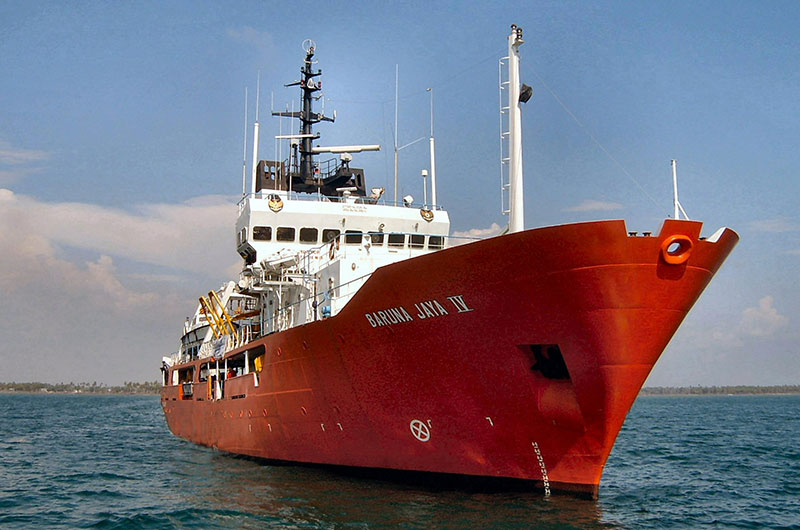
During the expedition, U.S. and Indonesian scientists will work side-by-side on two ships, the Okeanos Explorer and the Indonesian research vessel Baruna Jaya IV (shown here), and at Exploration Command Centers (ECCs) ashore. Image courtesy of the NOAA Office of Ocean Exploration and Research, INDEX-SATAL 2010. Download larger version (jpg, 1.1 MB).
Joint port events are scheduled in North Sulawesi Indonesia on July 20 and August 10.
NOAA Ship Okeanos Explorer is one of the newest additions to the NOAA fleet and was commissioned in 2008. It provides accommodations for up to 46 crew and technicians. Unique to this ship is that most of the scientists will remain ashore. Via telepresence, live images from the seafloor and other science data will flow over satellite and high-speed Internet pathways to scientists standing watches in ECCs in Jakarta, Indonesia, and Seattle, Washington. Those scientists, and others on call if a discovery is made at sea, will add their expertise in real time to operations at sea.

The Little Hercules remotely operated vehicle is a dual-body system capable of operating to depths of 4,000 meters. It is deployed from the Okeanos Explorer and attached to the ship by a tether. One vehicle is suspended above the other and serves to illuminate and image the surroundings. Image courtesy of the NOAA Office of Ocean Exploration and Research, INDEX-SATAL 2010. Download larger version (jpg, 592 KB).
One of the hallmarks of this expedition will be the high-definition video provided from the Little Hercules ROV. When deployed from the Okeanos Explorer, “Little Herc” will provide scientists and the audiences onshore with the very first video footage from deepwater areas of the Sangihe Talaud Region. All expedition participants are anxious to see the spectacular habitats and marine life we’ll discover.
The Indonesian research vessel Baruna Jaya IV is one of the newest vessels operated by the Indonesian Agency for the Assessment and Application of Technology (BPPT). It can accommodate up to 59 crew, technicians, and scientists. Though telepresence is not critical to its operations, Indonesian scientists recently outfitted the ship with the capability to also communicate with the Jakarta and Seattle ECCs.
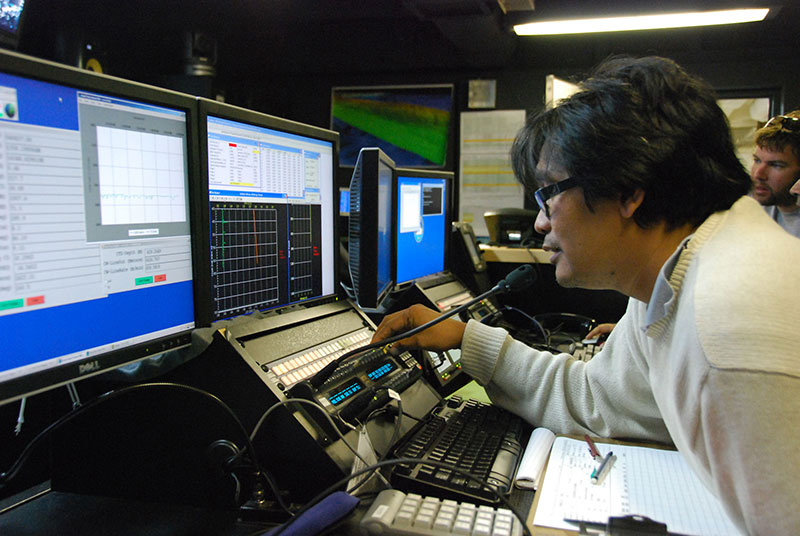
During preliminary operations near Guam, Indonesian, scientist Dr. Michael Purwoadi makes the first ‘call’ using telepresence from NOAA Ship Okeanos Explorer to colleagues in the newly established Jakarta Exploration Command Center. Image courtesy of the NOAA Office of Ocean Exploration and Research, INDEX-SATAL 2010. Download larger version (jpg, 964 KB).
Ocean expeditions are complicated enough when they only involve one ship and with all scientists on board. With multiple ships and a shore-side science team separated from each other by 14 hours, coordinating communications and operations is bound to be challenging and exciting.
Beyond the anticipated extraordinary science results, this maiden expedition of NOAA Ship Okeanos Explorer will also be critical to refining our operations paradigm for the future.
It takes knowledgeable people to make sound choices. Young people, especially, need the chance to become engaged and opportunities to become sound stewards. This joint expedition gives Indonesian and U.S. students just that opportunity, bringing materials linked to this shared adventure into their classrooms and right to their fingertips.
Educational products related to the expedition include this website with essays, daily mission logs, and imagery; near real-time ship tracking; and educational modules and lesson plans on biodiversity and natural hazards.
NOAA's partners in this expedition include the Indonesian Ministry of Marine Affairs and Fisheries, Indonesian Agency for the Assessment and Application of Technology, U.S. Embassy – Jakarta, University of Massachusetts, Woods Hole Oceanographic Institution, University of Victoria, University of Hawaii, the Exploratorium in San Francisco, and Sea World Indonesia.